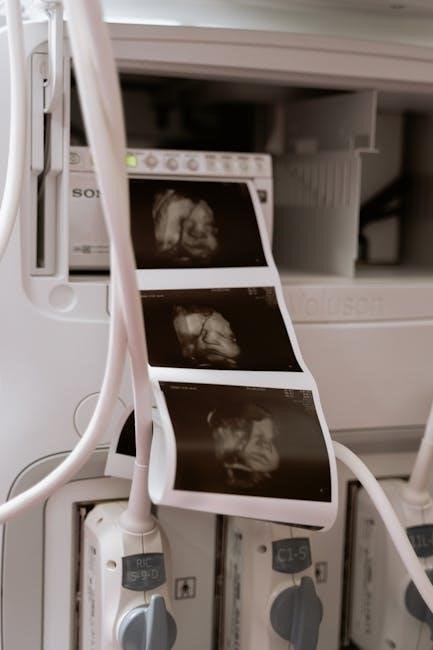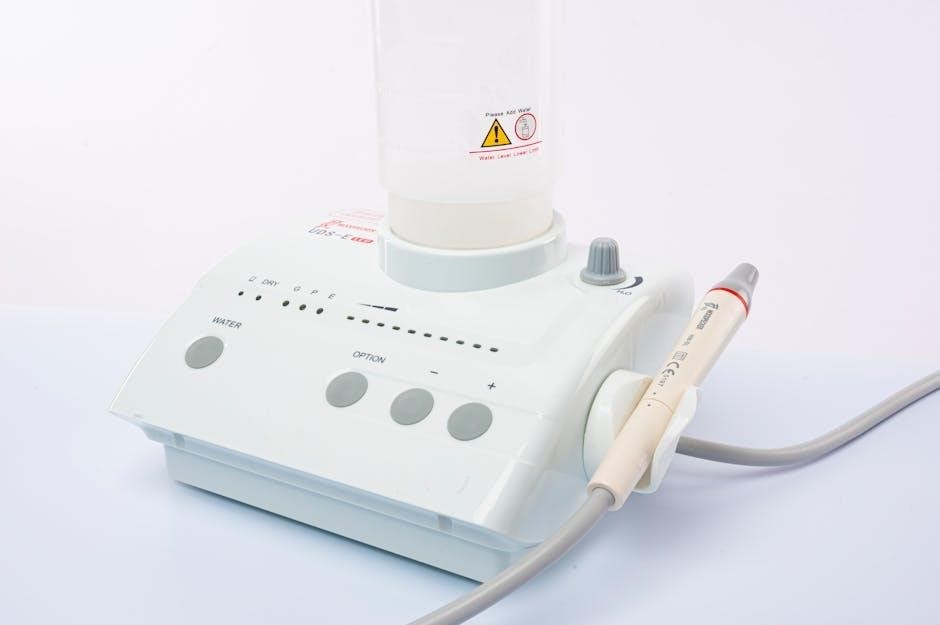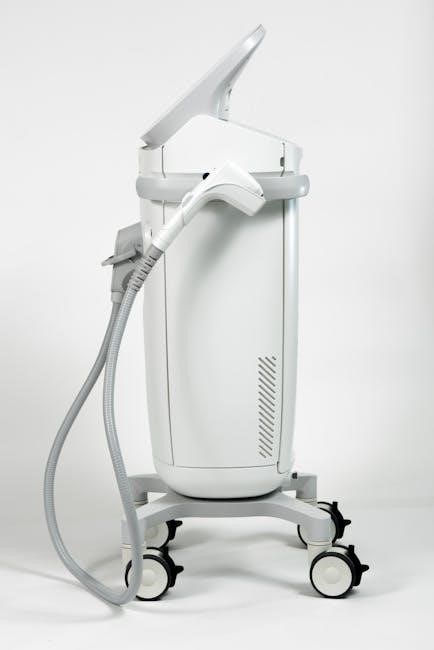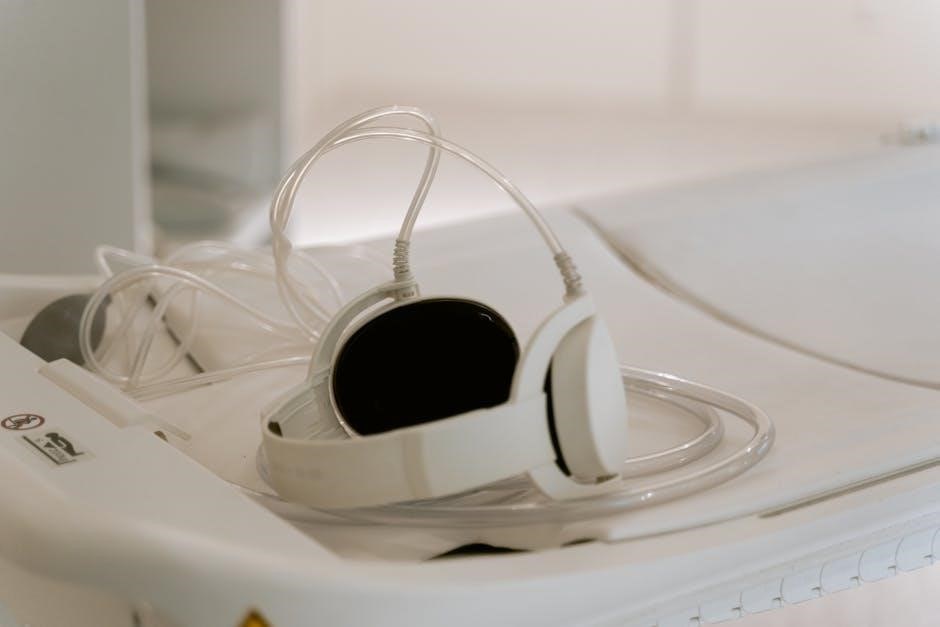Ultrasound-guided procedures involve using real-time ultrasound imaging to direct medical interventions, enhancing accuracy and safety. They are widely used in diagnostics, therapeutics, and pain management, offering precision and minimal invasiveness. These techniques have revolutionized modern medicine, reducing risks and improving patient outcomes. Their versatility and continuous advancements make them a cornerstone in contemporary healthcare practices.
1.1 Definition and Overview
Ultrasound-guided procedures refer to medical interventions where real-time ultrasound imaging directs the placement of needles, catheters, or other instruments. This technique enhances precision by providing live visualization, reducing complications and improving outcomes. Commonly used in diagnostics, such as biopsies, and therapeutics, like pain management, these procedures minimize risks compared to blind or landmark-based methods. The use of ultrasound ensures accurate targeting of anatomical structures, making it invaluable in various medical specialties. Operators require specialized training to interpret images and perform interventions effectively, ensuring patient safety and procedural success.
1.2 Importance in Modern Medicine
Ultrasound-guided procedures are integral to modern medicine, offering enhanced precision and safety in diagnostics and therapeutics. By providing real-time imaging, they reduce risks of complications, such as bleeding or nerve damage, compared to blind techniques. This method is particularly valuable in pain management, enabling accurate placement of medications or ablations. Its minimally invasive nature accelerates recovery times and improves patient comfort. The versatility of ultrasound guidance spans various specialties, from anesthesia to surgery, making it a critical tool in contemporary healthcare. Its adoption has significantly improved clinical outcomes and patient satisfaction across diverse medical applications.
1.3 Brief History and Evolution
The use of ultrasound in medical procedures traces back to the early 20th century, evolving from World War I sonar technology. The 1940s and 1950s saw its first diagnostic applications, with B-mode imaging emerging in the 1960s. By the 1980s, ultrasound-guided interventions became common, starting with biopsies and aspirations. Advances in transducer technology and imaging software have since expanded its applications. Modern systems integrate AI and real-time imaging, enhancing precision and safety. This evolution reflects continuous innovation, transforming ultrasound into a cornerstone of contemporary medicine, with ongoing advancements promising even greater capabilities in the future.

Key Concepts in Ultrasound-Guided Procedures
Ultrasound-guided procedures rely on real-time imaging for precise guidance, ensuring accuracy and safety. Key concepts include understanding wave propagation, tissue interaction, and probe manipulation. Effective use of search strategies, such as Boolean operators, enhances information retrieval for procedure optimization, while operator expertise and equipment calibration are critical for successful outcomes.
2.1 Basic Principles of Ultrasound Imaging
Ultrasound imaging operates on the principle of converting electrical energy into high-frequency sound waves using piezoelectric crystals. These waves penetrate tissues and reflect off structures, creating echoes. The ultrasound machine processes these echoes to produce images. Sound waves behave predictably in homogeneous tissues but vary with tissue density and elasticity. Reflection, refraction, and attenuation are key phenomena influencing image quality. Operators must understand wave propagation and tissue interaction to optimize imaging. Proper coupling with a conductive medium, like gel, ensures efficient wave transmission. Adjusting frequency and focal zones enhances image clarity, making ultrasound a versatile tool for guiding medical procedures effectively.
2.2 Role of the Operator in Guided Procedures
The operator plays a critical role in ultrasound-guided procedures, requiring extensive training and expertise. They must interpret real-time ultrasound images, ensuring accurate needle or instrument placement. Proficiency in anatomy, pathology, and ultrasound physics is essential. Effective patient communication and positioning are key to procedure success. Operators must maintain sterility, monitor patient safety, and adapt techniques based on dynamic tissue changes. Continuous learning and adherence to guidelines are vital for optimal outcomes. The operator’s skill directly impacts procedure efficiency, accuracy, and patient safety, making their role indispensable in modern medical practice.
2.3 Essential Equipment and Tools
Ultrasound-guided procedures require specialized equipment to ensure accuracy and safety. Key tools include high-resolution ultrasound machines, transducers (probes), biopsy needles, and imaging software. The ultrasound machine generates and processes images, while transducers convert electrical signals into sound waves. Biopsy needles are designed for precise tissue sampling under real-time guidance. Imaging software enhances visualization, aiding in diagnosis and intervention. Additional tools like patient positioning devices and sterile equipment are crucial for maintaining hygiene and stability during procedures. These tools collectively enable operators to perform interventions with high precision, minimizing complications and improving patient outcomes.

Technology Behind Ultrasound-Guided Procedures
Ultrasound-guided procedures rely on advanced imaging systems, high-frequency transducers, and specialized software. These technologies enable real-time visualization, enhancing precision and safety during medical interventions.
3.1 Types of Ultrasound Machines
Ultrasound-guided procedures utilize various machine types, including portable, cart-based, and specialized systems. Portable devices offer mobility, ideal for bedside use, while cart-based systems provide advanced features. Point-of-care (POC) ultrasounds are compact, enabling quick assessments. Specialized machines, like those for cardiology or musculoskeletal imaging, feature high-frequency transducers for detailed visualization. These systems incorporate advanced software, such as tissue harmonic imaging and Doppler modes, enhancing image quality. Modern machines also integrate AI for improved diagnostics. Each type caters to specific clinical needs, ensuring versatility and precision in guiding medical interventions across diverse specialties.
3.2 Probe and Transducer Technology
Central to ultrasound-guided procedures are probes, or transducers, which convert electrical energy into sound waves and detect returning echoes. These devices vary in frequency, shape, and size, tailored for specific applications. Linear probes are ideal for superficial structures, while curved probes offer a wider field of view for deeper tissues. Phased-array probes are used for cardiac imaging. Advanced transducer materials, such as piezoelectric ceramics, enhance sensitivity and resolution. Modern probes incorporate ergonomic designs for operator comfort and maneuverability. High-frequency probes provide superior image quality, while lower frequencies penetrate deeper tissues. Regular maintenance and sterilization ensure optimal performance and patient safety.
3.4 Software and Imaging Enhancements
Modern ultrasound systems employ advanced software and imaging enhancements to optimize procedure outcomes. Tissue harmonic imaging improves image clarity by reducing artifacts, while elastography assesses tissue stiffness for diagnostic insights. Contrast-enhanced ultrasound uses microbubbles to highlight blood flow and lesion vascularity. Advanced algorithms enhance edge detection and noise reduction, providing sharper images. Software tools, such as guided biopsy systems, assist in precise needle placement. These technologies integrate seamlessly with transducer data, enabling real-time adjustments for superior imaging. Such innovations enhance diagnostic accuracy, procedural efficiency, and patient safety, making ultrasound-guided interventions more effective and reliable in clinical practice.

Clinical Applications of Ultrasound-Guided Procedures
Ultrasound-guided procedures are widely applied in diagnostics, therapeutics, and pain management. They enable precise tissue sampling, targeted injections, and minimally invasive treatments, enhancing patient care and outcomes.
4.1 Diagnostic Procedures
Ultrasound-guided diagnostic procedures, such as biopsies and aspirations, enable precise tissue sampling under real-time imaging. This method enhances accuracy, minimizing complications and improving diagnostic confidence. It is commonly used for evaluating suspicious lesions, assessing organ abnormalities, and guiding fine-needle aspirations. The real-time visualization allows for targeting specific areas, ensuring optimal sample collection while reducing patient discomfort. These techniques are invaluable in oncology, hepatology, and other specialties, providing critical diagnostic information that informs treatment plans. Regular training and adherence to safety protocols ensure the effectiveness of these procedures in clinical practice.
4.2 Therapeutic Interventions
Ultrasound-guided therapeutic interventions involve using real-time imaging to deliver targeted treatments, such as injections, tumor ablation, or cyst drainage. These procedures ensure precise placement of therapeutic agents, minimizing risks and improving efficacy. Common applications include joint injections for arthritis, nerve blocks for pain relief, and localized cancer treatments. The ability to visualize the target area enhances safety and reduces complications. This approach is particularly beneficial for deep or hard-to-reach tissues, offering a minimally invasive alternative to traditional methods. Continuous advancements in technology further expand the range of conditions treatable with ultrasound guidance, improving patient outcomes and reducing recovery times.
4.3 Pain Management Techniques
Ultrasound-guided pain management techniques enable precise delivery of anesthetics or anti-inflammatory medications to targeted areas, such as nerves, joints, or soft tissues. Common procedures include epidural injections, facet joint injections, and nerve blocks. Real-time imaging ensures accurate needle placement, reducing risks of complications and improving therapeutic efficacy. These techniques are particularly effective for chronic pain conditions, such as lower back pain or arthritis. By minimizing systemic medication use, ultrasound-guided interventions offer a safer, more targeted approach to pain relief, enhancing patient comfort and accelerating recovery. This method is increasingly preferred for its accuracy and minimal invasiveness.
4.4 Surgical Applications
Ultrasound-guided procedures play a pivotal role in surgical applications, enhancing precision and minimizing complications. Surgeons use real-time imaging to guide tumor ablation, biopsy needle placement, and anatomical dissection. In orthopedic surgeries, ultrasound aids in joint injections and fracture reductions. Its real-time feedback allows for accurate tissue targeting, reducing the risk of damage to surrounding structures. This technique is particularly valuable in minimally invasive surgeries, where visualization is limited. By integrating ultrasound guidance, surgeons achieve better outcomes, shorter recovery times, and reduced patient morbidity, making it an indispensable tool in modern surgical practices.

Training and Certification Requirements
Training and certification are crucial for mastering ultrasound-guided procedures, ensuring patient safety and procedural accuracy. Operators must undergo specialized education and hands-on training to achieve competency.
5.1 Educational Pathways for Operators
Operators typically pursue formal education in medicine, sonography, or related fields, followed by specialized residency or fellowship training. Many complete certified programs in diagnostic or interventional ultrasound. Continuing education is essential to stay updated on advancements. Institutional training often includes hands-on practice with ultrasound devices. Mentorship from experienced professionals is highly valued. Certification from recognized bodies, such as the American Registry for Diagnostic Medical Sonography, is often required. These pathways ensure operators acquire the theoretical knowledge and practical skills needed for safe and effective ultrasound-guided procedures, adhering to professional standards.
5.2 Hands-On Training and Simulation
Hands-on training and simulation are critical for mastering ultrasound-guided procedures. Operators engage in practical exercises using real or simulated equipment, allowing them to refine their skills in a controlled environment. Simulation models, such as virtual reality platforms and phantom tissue, replicate real-world scenarios, enabling repetitive practice without patient risk. Experienced instructors provide immediate feedback, enhancing technical proficiency and decision-making. These tools also familiarize operators with diverse anatomical variations and challenging cases, building confidence and competence. Simulation-based training ensures operators can perform procedures safely and effectively, reducing errors and improving patient outcomes in clinical settings.
5.3 Maintenance of Certification
Maintenance of certification for ultrasound-guided procedures ensures ongoing competency and adherence to evolving standards. Operators must complete continuing education requirements, often through accredited programs or professional societies. These programs include updates on advanced techniques, new technologies, and safety protocols. Recertification typically involves periodic assessments or exams to verify skill retention and knowledge of best practices; Additionally, professionals must demonstrate ongoing clinical experience and engagement in professional development activities. This process ensures that operators remain proficient and up-to-date, delivering safe and effective care. Regular recertification is essential for maintaining credibility and patient trust in ultrasound-guided procedures.

Safety and Complications in Ultrasound-Guided Procedures
Ensuring patient safety is paramount, requiring skilled operators and adherence to strict protocols. Potential complications, such as infections or bleeding, demand meticulous technique and post-procedure care.
6.1 Patient Safety Considerations
Patient safety is a top priority in ultrasound-guided procedures, requiring meticulous preparation and adherence to established protocols. Proper sterilization of equipment, such as probes and needles, is essential to prevent infections. Operators must ensure the patient is positioned correctly to avoid discomfort or injury. Continuous monitoring of the patient’s vital signs during the procedure is crucial. Clear communication between the patient and healthcare provider helps in identifying any potential risks early. Additionally, using appropriate local anesthesia and maintaining aseptic technique minimizes complications. Regular training and updates for operators further enhance safety standards, ensuring optimal outcomes for patients undergoing these procedures.
6.2 Common Complications and Risks
While ultrasound-guided procedures are generally safe, certain complications and risks exist. Bleeding or hematoma formation is a common risk, especially in biopsy or vascular procedures. Infection, though rare, can occur if sterilization protocols are not followed. Nerve damage or inflammation may result from improper needle placement. Additionally, patients may experience discomfort or pain during or after the procedure. In rare cases, probe malfunctions or equipment failure can complicate the process. Proper training and adherence to guidelines significantly reduce these risks, ensuring safer outcomes for patients undergoing ultrasound-guided interventions.
6.3 Preventative Measures
To minimize complications, operators must adhere to strict sterile techniques and proper probe disinfection. Thorough patient assessment before procedures helps identify risks like bleeding tendencies. Real-time ultrasound imaging ensures precise needle placement, reducing nerve or vascular damage. Regular equipment maintenance and operator training are essential to prevent technical failures. Clear communication with patients about risks and post-procedure care enhances safety. Adhering to established protocols and guidelines further mitigates potential complications, ensuring safer and more effective ultrasound-guided interventions.

Comparison with Traditional Methods
Ultrasound-guided procedures offer enhanced accuracy and reduced complications compared to traditional landmark-based techniques. Real-time imaging ensures precise targeting, minimizing risks and improving patient safety significantly.
7.1 Advantages Over Landmark-Based Techniques
Ultrasound-guided procedures significantly outperform landmark-based methods by providing real-time visualization, improving accuracy, and reducing complications. They allow precise targeting of anatomical structures, minimizing errors and enhancing patient safety. Unlike traditional techniques, ultrasound guidance enables dynamic adjustments during procedures, ensuring optimal outcomes. This approach also reduces the risk of nerve or vascular damage, common in blind or landmark-based methods. Additionally, ultrasound-guided procedures are less invasive, promoting faster recovery and higher patient satisfaction. Overall, they offer a more reliable and efficient alternative, making them a preferred choice in modern medical practice.
7.2 Limitations and Challenges
Despite their advantages, ultrasound-guided procedures face challenges such as operator dependency, requiring extensive training and expertise. Image quality can be compromised by factors like obesity or air interference, potentially hindering accuracy. Additionally, deep tissue visualization remains limited, restricting its applicability in certain cases. The cost of advanced ultrasound systems and maintenance further complicates widespread adoption. These challenges highlight the need for skilled professionals and continuous technological advancements to enhance the effectiveness and accessibility of ultrasound-guided interventions.
7.3 Cost-Benefit Analysis
Ultrasound-guided procedures offer significant benefits, but their implementation involves notable costs. The initial investment in advanced equipment, training, and maintenance can be substantial. However, these expenses are often offset by reduced complications, shorter recovery times, and improved patient outcomes. Long-term savings arise from minimized hospital stays and decreased need for additional treatments. While the upfront costs may pose a barrier, the overall value of enhanced accuracy and safety frequently justifies the investment, making ultrasound-guided interventions a cost-effective option in modern healthcare.

Future Trends and Innovations
Future trends include AI-driven diagnostics, portable ultrasound devices, and expanded applications in neurology and cardiology. These innovations aim to enhance accessibility, precision, and versatility in healthcare settings.
8.1 Emerging Technologies in Ultrasound Guidance
Emerging technologies in ultrasound guidance include portable devices, AI-integrated systems, and advanced probe designs. Portable ultrasound machines enhance accessibility in remote settings, while AI algorithms improve image interpretation and diagnostic accuracy. Innovations like MRI-guided focused ultrasound enable precise tissue targeting for treatments. Additionally, advancements in probe technology, such as high-frequency transducers, offer clearer imaging. These technologies are transforming ultrasound-guided procedures, enabling faster, more accurate, and less invasive interventions. They are reshaping healthcare by expanding diagnostic and therapeutic capabilities, ensuring better patient outcomes and streamlined clinical workflows.
8.2 Artificial Intelligence Integration
Artificial intelligence is revolutionizing ultrasound-guided procedures by enhancing image analysis and decision-making. AI algorithms can automate image interpretation, detect abnormalities, and guide operators in real-time. Machine learning models improve diagnostic accuracy by analyzing vast datasets, reducing human error. AI also streamlines workflows, enabling faster procedures and better patient care. Integration of AI in ultrasound systems assists in complex interventions, such as biopsies and tumor treatments, by providing predictive analytics and precision guidance. This synergy between ultrasound and AI is advancing the field, offering new possibilities for early diagnosis and effective treatment, ultimately improving patient outcomes and clinical efficiency.
8.3 Expanding Applications in New Fields
Ultrasound-guided procedures are expanding into innovative areas, including cosmetic surgery, stem cell therapy, and veterinary medicine. In cosmetics, they enable precise fat reduction and facial enhancements. Stem cell therapies benefit from ultrasound guidance for accurate delivery; Veterinary applications now include guided biopsies and treatments, improving animal care. These emerging uses leverage ultrasound’s real-time imaging to enhance precision and minimize invasiveness. Advances in AI and imaging software further broaden these applications, offering new possibilities for diverse medical specialties. This expansion underscores the versatility of ultrasound technology in addressing complex challenges across various fields, driving innovation and improving outcomes.
Patient Benefits and Outcomes
Ultrasound-guided procedures enhance patient care by improving accuracy, reducing recovery time, and minimizing complications. They offer precise results, higher satisfaction, and safer outcomes, benefiting patients significantly.
9.1 Improved Accuracy and Precision
Ultrasound-guided procedures significantly enhance accuracy by providing real-time imaging, allowing precise needle or instrument placement. This reduces human error and improves diagnostic or therapeutic outcomes. The ability to visualize target structures ensures interventions are performed with greater confidence, minimizing complications. Enhanced precision also leads to better patient outcomes, as procedures are more effectively targeted. This level of accuracy is particularly valuable in delicate or hard-to-reach areas, where traditional methods may fall short. Overall, the use of ultrasound guidance revolutionizes precision in medical interventions;
9.2 Reduced Recovery Time
Ultrasound-guided procedures often result in reduced recovery time for patients due to their minimally invasive nature. By precisely targeting areas with real-time imaging, these methods minimize tissue trauma, leading to less post-procedure pain and faster healing. Patients typically experience shorter hospital stays and quicker return to normal activities. The reduced risk of complications also contributes to faster recovery, as fewer interventions are needed post-procedure. This approach not only improves patient outcomes but also enhances overall satisfaction by accelerating the return to daily life and reducing the need for extended care or rehabilitation.
9.3 Enhanced Patient Satisfaction
Ultrasound-guided procedures significantly enhance patient satisfaction due to their precision and minimally invasive nature. Patients benefit from reduced pain, faster recovery, and minimal scarring, leading to improved comfort and confidence. Real-time imaging provides transparency, allowing patients to understand the procedure better. Additionally, the reduced need for overnight hospital stays and quicker return to daily activities contribute to higher satisfaction levels. Enhanced outcomes, coupled with a more positive experience, make ultrasound-guided procedures a preferred choice for patients seeking effective and efficient care with minimal disruption to their lives.
Ultrasound-guided procedures have revolutionized healthcare by enhancing accuracy, safety, and patient satisfaction. Their minimally invasive nature and real-time imaging ensure precise outcomes, reducing recovery times and improving care quality. As technology advances, these procedures will continue to play a pivotal role in modern medicine, offering innovative solutions for diagnostics and treatments.
10.1 Summary of Key Points
Ultrasound-guided procedures have transformed healthcare by offering precise, real-time imaging for diagnostics and treatments. These methods enhance accuracy, minimize risks, and reduce recovery times. They are widely applied in pain management, biopsies, and surgical interventions, improving patient outcomes. The use of advanced technology, such as high-resolution probes and AI integration, further elevates their effectiveness. Training and certification ensure operators deliver safe and reliable care. Overall, ultrasound-guided procedures represent a cornerstone of modern medicine, balancing innovation with patient-centric approaches to achieve optimal results across various clinical applications.
10.2 Future Prospects
The future of ultrasound-guided procedures is promising, with advancements in AI and machine learning poised to enhance precision and accessibility. Emerging technologies, such as handheld devices and enhanced imaging software, will expand their applications in diagnostics and therapeutics. Integration with robotics and real-time data analytics could further improve outcomes. Additionally, the development of portable and affordable systems may increase adoption in underserved areas. These innovations, coupled with ongoing research, will likely broaden the scope of ultrasound-guided interventions, making them more efficient and patient-centric. The field is expected to continue evolving, offering transformative possibilities for healthcare worldwide.